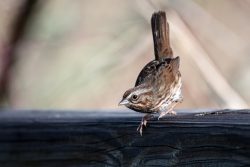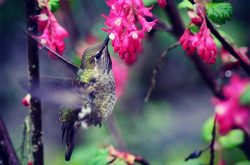
Quarantine and social distancing are teaching us creative ways to interact with each other and the world at large. One way to stay connected with the natural world (and take a much needed break from screens) is to head to your window to watch the goings on of your neighborhood and visiting birds.
There are a surprisingly large number of bird species that can be observed right from your living room, depending on the vegetation in your backyard, alley or street. Birds will naturally congregate around food and shelter, and what you have outside your window will shape your local bird scene.
Tips on spotting birds:
- Instead of darting your eyes around to try and find birds, sit still and focus your attention on one spot. Slowly, you’ll notice little bits of movement in your periphery — these might be leaves and branches moving in the wind, but they are often small birds moving about on bushes and in tree branches.
- Return to your window at different times of day. Birds have different daily routines, just like us. When it’s not breeding season, crows, for instance, commute daily to converge and sleep in the protected vegetation that alerts them of predators. In the fall and winter, you can see them in huge numbers flying home to roost in Bothell.
- Listen! Some birds are louder than others (I’m looking at you Steller’s Jay), and it can be useful to “look” by focusing on the different calls you hear. It’s much easier to spot a hummingbird by hearing it and then looking for the tiny bird up in the branches.

Tools to help you on your bird journey:
- The Cornell Lab is a fantastic online resource with pictures, bird calls, and a great instant ID tool to help you figure out what your mystery species might be.
- Keep a copy of a field guide, like the Sibley Field Guide to Birds of Western North America, handy. It has detailed illustrations and is a favorite of some birders.
- For this level of birding, a pair of binoculars can be helpful, but is not necessary. Avoid looking like a peeping tom by pointing them away from your neighbor’s windows!
While observing these species, keep a bird journal! Record numbers and behaviors. Try to see if you can identify individuals by any physical differences and behavior and location patterns you might see — it’s a way of meeting neighbors that you may not already know. What behaviors are you seeing? Are birds calling to warn others of a potential predator, returning to nests with food or rubbing their beaks on fence posts?
Invite your friends to bird with you (virtually) so you can compare notes and help each other out with identification.
Lastly, when we are ready to rejoin society, take these new skills out to the field. The UW Center for Urban Horticulture’s Union Bay Natural Area and the Washington Park Arboretum are fantastic places to observe birds and reap the benefits of time spent in nature.
Below are common and easy to identify birds that are known in the Pacific Northwest. Try to spot them and learn their calls.
Birds to find in urban and suburban areas:

Crows
Dark-eyed Juncos
European Starlings
Finches
Golden-crowned Kinglets
Hummingbirds
Northern Flickers
Robins
Song and House Sparrows
Spotted Towhees
Steller’s and Scrub Jays
Warblers
Marsh and Pacific Wrens
Birds to find near or on the water:

Bald eagles
Canada geese
Cormorants
Great Blue herons
Gulls
Mallard Ducks
Mergansers
Red-winged blackbirds
Sandpipers
Scaup

